by Lisa Cooke | Oct 14, 2019 | 01 What's New, MyHeritage
The second annual MyHeritage user conference, MyHeritage LIVE 2019, was held in Amsterdam.

Below you’ll find a list of lectures from the conference which are now online. These sessions, given by world-renowned experts and valued MyHeritage staff, are now available on MyHeritage Education.
If you missed the conference or the live stream, you can now take watch these video recordings for free, from the comfort of your own home, at any time, and at your own pace.
Pick from this List of MyHeritage Video Classes
Here is a list with a full description of each and links to watch them:
Opening Session: Keynote by MyHeritage Founder and CEO Gilad Japhet
In his keynote address at MyHeritage LIVE, MyHeritage Founder and CEO, Gilad Japhet, talks about recent MyHeritage achievements as well as upcoming features and projects
Watch
What’s New at MyHeritage
with Maya Lerner
Maya Lerner, VP of Product at MyHeritage, gives a summary of MyHeritage’s new features and a look ahead at future plans.
Watch

Introducing the New Educational Resource Center for MyHeritage Users
with Daniel Horowitz
This presentation will give you an inside look at MyHeritage Education, a new online resource center for enhancing your understanding of the MyHeritage platform.
Watch
Hear my interview with Daniel Horowitz in Genealogy Gems Podcast episode #221.

Searching and Browsing on MyHeritage to Get the Most Out of Your Research
with Cyndi Ingle
With 10 billion historical records, MyHeritage is able to provide the most extensive genealogy searches available on the Internet. Learn how to use them efficiently to find new and relevant information to incorporate into your research.
Watch
Discovering Immigration Stories with MyHeritage
with Lisa Alzo
Every immigrant has a story. Learn how to leverage the immigration records collection at MyHeritage to uncover key clues and make amazing discoveries about your immigrant ancestors from both sides of the pond.
Watch
Lisa Alzo has been a guest blogger here at Genealogy Gems. Her articles include Heritage Receipts – Aunties, Sprinkles and the Santa-in-his-cap cookie cutter and 4 Steps to Getting Started with Scrivener Software for Writing Family History.
Using MyHeritage to Find Ancestors from the Netherlands
with Yvette Hoitink
If you have ancestors from the Netherlands, this talk introduces you to the most important records and shows you what you can find online, even if you don’t know any Dutch. Learn how naming traditions and emigration patterns can help you find your Dutch ancestors.
Watch
PANEL: Researching Dutch Family History Around the World
These experts give tips and advice on how to research your roots in Surinam and the former Dutch East Indies.
Watch
Evaluating Your Smart Matches™ and Record Matches on MyHeritage
with James Tanner
Smart Matches™ and Record Matches on MyHeritage supercharge your research. Learn how to review and evaluate these automatically generated matches and effectively use them to advance your genealogical research goals.
Watch
An Overview of Western European Record Collections on MyHeritage
with Mike Mansfield of MyHeritage
With over three billion records from thousands of collections of European origin and a vibrant user community, MyHeritage is an incredible resource for European research. This session will provide an overview of these collections and highlight how to best find access and utilize these sources.
Watch
Using Geni and How it is Different from Other Genealogy Platforms
with Mike Stangel
Learn more about the benefits of collaboration in a single-family tree, including adding sources to shared profiles, communicating with public discussions, understanding the revision history of profiles, and working with projects. Learn how Geni and MyHeritage work together to help improve the quality of the World Family Tree and connect you to new relatives.
Watch
Top Technology Tips for MyHeritage Users & Introduction to Family Tree Webinars
with Geoff Rasmussen
Watch
Developing Your Own Research Plan on MyHeritage
with James Tanner
MyHeritage provides an extremely valuable platform for conducting systematic and source-based research. A formal research plan can help you organize all the information presented in a coherent, useful way, and keep you moving towards your genealogical goals.
Watch
Using Census, Immigration, Newspaper, and Yearbook Records at MyHeritage to Explore the LIves of Your Ancestors
with Lisa Alzo
In genealogy, cluster and collateral research is a key strategy for solving complex brick wall problems. Learn how to use census, immigration, newspaper, and yearbook records at MyHeritage to explore the lives of your ancestors and their inner circles.
Watch

Science for the Non-Scientist: How Does MyHeritage Produce their DNA Results?
with Diahan Southard
DNA test results are a companion to our other research methods. A better understanding of how it all works will lead to better use of the tools for your family history research.
Watch
Diahan has been a regular contributor here at Genealogy Gems. Read her article Adoption DNA Match Strategy: Combine DNA Test Types.
Click the video player below to watch my conversation with Diahan about common genetic genealogy misconceptions:
What Exactly is a Centimorgan? An Introduction to the Science of DNA Testing
with Ran Snir
Whether you have already taken a DNA test or this is the first time you’re hearing about it, in this session we will start from the very beginning. We’ll go over the basic terms of DNA testing and learn how DNA is passed down through generations, how and why individuals have shared DNA segments and how we’re able to estimate one’s ethnicity origins.
Watch
Ran Snir was featured in Genealogy Gems Podcast episode #227. Click here to hear my interview with him on the Theory of Family Relativity™.
Mapping Your DNA Matches on MyHeritage
with Blaine Bettinger
Learn about useful tools to organize your list of DNA Matches, how to differentiate between them, and how to better utilize each tool.
Watch
Using the Theory of Family Relativity™ to Research Your DNA Matches
with Ran Snir
Learn about the revolutionary technology that saves you dozens of hours of research by synthesizing billions of data points to craft multiple theories about how you and your DNA Matches might be related.
Watch
PANEL: The Future of DNA Testing
Roberta Estes, Blaine Bettinger, Yaniv Erlich
This panel of DNA experts discusses the current state of DNA testing and what the future will bring.
Watch
Formulating a DNA Testing Plan
with Blaine Bettinger
DNA testing can be expensive, but DNA evidence is a component of exhaustive research when it is available. Identify some of the ways you can minimize costs while maximizing results by formulating a DNA testing plan early in your research.
Watch
Why You Should Complement Your DNA Data with Genealogy Research
with Diahan Southard
Building a family tree is free and adds a lot of value to your DNA test. Learn how it can help improve the accuracy of relationship estimates, trace common ancestors to uncover how exactly you are related, increase the chances DNA Matches will contact you, help you identify the family members whose DNA results would contribute the most value to your research, and more.
Watch
The World Wide DNA Web
with Alon Diament Carmel
Alon Diament Carmel, Ph.D., researcher for the MyHeritage science team, explains what we can learn from the vast web billions of DNA Matches about genetic groups and identity.
Watch
Introducing the MyHeritage DNA Health+Ancestry Test
with Yaniv Erlich
Discover how your genes affect your health and explore the valuable insights you can gain from this latest addition to our DNA product line. The MyHeritage DNA Health+Ancestry test gives you dozens of personalized health reports that explain your genetic risk for developing certain conditions, and tell you whether you’re a carrier for hereditary conditions that can potentially be passed on to your children.
Watch
PANEL: DNA Testing for Health
with Yaniv Erlich, Diahan Southard, Roberta Estes
This panel of DNA experts discusses the advantages of taking a Health DNA test to learn more about how your genes may affect your health and empower you for the future.
Watch
by Lisa Cooke | Jul 21, 2017 | 01 What's New, British, Irish, Maps, Records & databases
Digitized Irish historical maps are among new genealogy records online. Also: Irish civil registrations; Irish, British, and Scottish newspapers; Westminster, England Roman Catholic records; wills and probates for Wiltshire, England and, for the U.S., WWI troop transport photos, Tampa (FL) photos, Mayflower descendants, NJ state census 1895, western NY vital records, a NC newspaper, Ohio obituaries, and a Mormon missionary database.
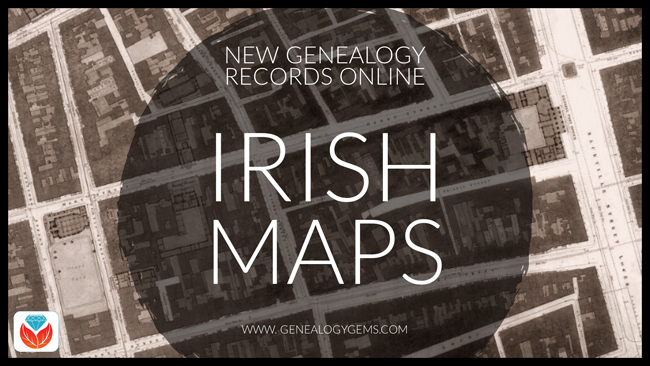
Beautiful Irish historical maps
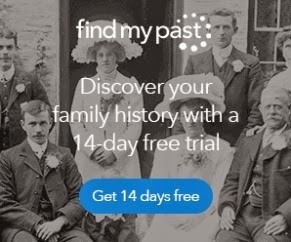 Findmypast.com has published two fantastic new Irish historical map collections:
Findmypast.com has published two fantastic new Irish historical map collections:
- Dublin City Ordnance Survey Maps created in 1847, during the Great Famine. “This large-scale government map, broken up into numerous sheets, displays the locations of all the streets, buildings, gardens, lanes, barracks, hospitals, churches, and landmarks throughout the city,” states a collection description. “You can even see illustrations of the trees in St Steven’s Green.”
- Ireland, Maps and Surveys 1558-1610. These full-color, beautifully-illustrated maps date from the time of the English settlement of Ulster, Ireland. According to a collection description, the maps “were used to inform the settlers of the locations of rivers, bogs, fortifications, harbors, etc. In some illustrations, you will find drawings of wildlife and even sea monsters. Around the harbors, the cartographers took the time to draw meticulously detailed ships with cannons and sailors. Many of the maps also detailed the names of the numerous Gaelic clans and the lands they owned, for example, O’Hanlan in Armagh, O’Neill in Tyrone, O’Connor in Roscommon, etc.”
(Want to explore these maps? Click on the image above for the free 14-day trial membership from Findmypast.com!)
More Ireland genealogy records
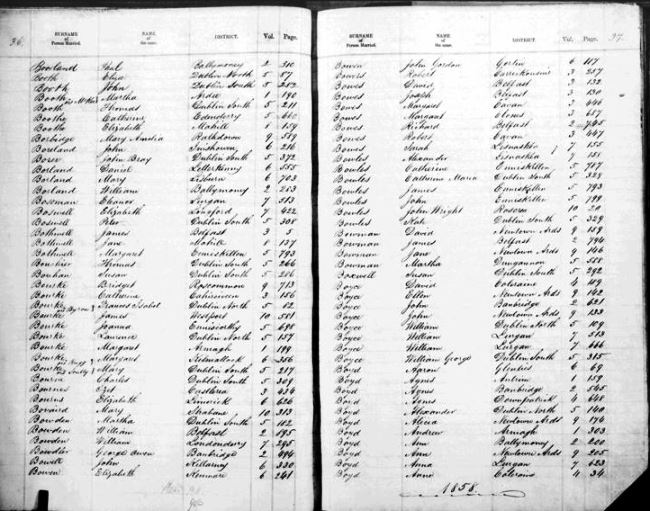
Sample page, Ireland marriage registrations. Image courtesy of FamilySearch.
FamilySearch.org now hosts a free online collection of Ireland Civil Registration records, with births (1864-1913), marriages (1845-1870), and deaths (1864-1870). Images come from original volumes held at the General Register Office. Click here to see a table of what locations and time periods are covered in this database. Note: You can also search free Irish civil registrations at IrishGenealogy.ie.
New at the British Newspaper Archive
The Irish Independent, a new national title for Ireland, is joined in the Archive this week by eight other brand new titles. These include four titles for Scottish counties: Aberdeenshire, Lanarkshire, Angus (Forfanshire) and Wigtownshire. There are also four new papers for England, two of which are from London (Fulham & Hampstead), one for Worcestershire and one for West Yorkshire. Also, significant additions have been made to the British Newspaper Archive’s online coverage for the Brechlin Advertiser (Scotland, added coverage for 1925-1957) and Southend Standard and Essex Weekly Advertiser (added coverage for 1889-1896).
Roman Catholic Records for Westminster, England
Over 121,000 new Roman Catholic parish records for the Diocese of Westminster, England are now available to search on Findmypast.com in their sacramental records collections:
- Parish baptisms. Over 94,000 records. The amount of information in indexed transcripts varies; images may provide additional information such as godparents’ names, officiant, parents’ residence, and sometimes later notes about the baptized person’s marriage.
- Parish marriages. Nearly 9,000 additional Westminster records have been added. Transcripts include couples’ names, marriage information, and father’s names. Original register images may have additional information, such as names of witnesses and degree of relation in cases of nearly-related couples.
- Parish burials. Transcripts include date and place of burial as well as birth year and death; images may have additional information, such as parents’ names and burial or plot details.
- Additional congregational records. More than 16,000 indexed records of confirmations, donations, and other parish records are included here.
London Marriage Licences 1521-1869
Findmypast has published a searchable PDF version of a published volume of thousands of London Marriage Licenses 1521-1869. Search by name, parish, or other keyword. A collection description says, “Records will typically reveal your ancestor’s occupation, marital status, father’s name, previous spouse’s name (if widowed) and corresponding details for their intended spouse.” Note: The full digital text of this book is free to search at Internet Archive.
Wills and Probate Index for Wiltshire, England
Explore more than 130,000 Wiltshire Wills and Probate records in the free Findmypast database, Wiltshire Wills and Probate Index 1530-1881. “Each record consists of a transcript that will reveal your ancestor’s occupation, if they left a will and when they left it,” says a description. “The original Wiltshire wills are held at the Wiltshire and Swindon Archive. The source link in the transcripts will bring you directly to their site where you can view their index and request an image. If you wish to view an image, you will have to contact Wiltshire Council and a small fee may be required for orders by post.”
New records across the United States
WWI: Ancestry.com subscribers may now access a new online collection of photographs of U.S., WWI Troop Transport Ships, 1918-1919. Browse to search by ship name.
Florida. The city of Tampa, Florida has digitized and published two historic photo collections on Hillsborough County Public Library Cooperative Digital Collections:
- The Greater Tampa Chamber of Commerce Collection includes over 30,000 images of Tampa events dating from about 1950 until 1990, and includes many local officials and dignitaries.
- The Tampa Photo Supply Collection includes more than 50,000 images of daily life and special events (weddings, graduations) taken by local commercial photographers between 1940 and 1990, primarily in West Tampa, Ybor City, and South Tampa.
Mayflower descendants. AmericanAncestors.org has published a new database of authenticated Mayflower Pilgrim genealogies: Mayflower Families Fifth Generation Descendants, 1700-1880. The collection includes the carefully-researched names of five generations of Mayflower pilgrim descendants.
New Jersey. The New Jersey State Census of 1895 is now free to search at FamilySearch.org, which also hosts an 1885 New Jersey state census collection. “The state of New Jersey took a state census every 10 years beginning in 1855 and continuing through 1915, says a FamilySearch wiki entry. “The 1885 census is the first to survive in its entirety.” Click here to learn more about state censuses in the United States.
New York. Ancestry.com has published a searchable version of a genealogy reference book, 10,000 Vital Records of Western New York, 1809-1850. According to a collection description, “The 10,000 vital records in this work were drawn from the marriage and death columns of five western New York newspapers published before 1850….Birth announcements were not published in these early newspapers, but many of the marriage and death notices mentioned birth years, birthplaces, and parents’ names, and where appropriate such data has been copied off and recorded here.”
North Carolina. The first 100 years of the Daily Tar Heel newspaper are now free to search in digitized format at the North Carolina Digital Heritage Center. The collection spans 1893-1992 and includes over 73,000 pages from more than 12,000 issues. Click here for a related news article.

Ohio. FamilySearch also now hosts an index to Ohio, Crawford County Obituaries, 1860-2004, originally supplied by the county genealogical society. Obituaries may be searched or browsed; images may include additional newspaper articles (not just obituaries).
Utah and beyond (Latter-day Saint). The Church of Jesus Christ of Latter-day Saints (Mormons) has published a database of early missionaries. It covers about 40,000 men and women who served between 1830 and 1930, and may link to items from their personal files, including mission registry entries, letters of acceptance, mission journal entries, and photos. Those who are part of FamilySearch’s free global Family Tree will automatically be notified about relatives who appear in this database, and may use a special tool to see how they are related. Others may access the original database here. Click here to read a related news article.
Keep up with new and updated genealogy records online by subscribing to our free weekly email newsletter!

Disclosure: This post contains affiliate links and Genealogy Gems will be compensated if you make a purchase after clicking on these links. Thank you for supporting Genealogy Gems!
by Lisa Cooke | May 6, 2017 | 01 What's New, British, Legacy Tree Genealogists
With about 1/3 of Americans claiming British ancestry, chances are that at some point you will need to extend your research across the Atlantic Ocean. Genealogical research in the British Isles has some important differences when compared to the United States. Guest blogger Kate Eakman, a Senior Researcher for Legacy Tree Genealogists, clarifies confusing terms and helps you get your research started on solid footing!

Britain? England? The United Kingdom?
When beginning British genealogy research, it’s important to first talk about the difference between British and English research. There are several terms which get used interchangeably but which really refer to different locations.
Great Britain is an island, the largest island in the British Isles.
On the island of Great Britain are three of the four sovereign nations which make up the United Kingdom, or the U.K.: England, Wales, and Scotland. Northern Ireland on the island of Ireland is the fourth country of the U.K.
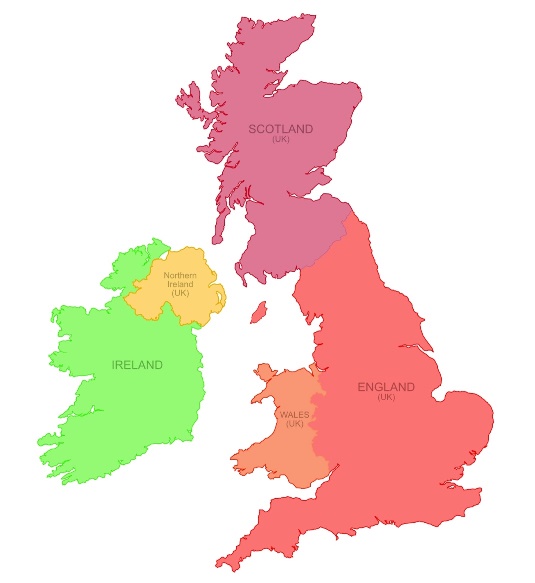
The four countries of the United Kingdom and the Republic of Ireland. Map courtesy Nate Parker.
Usually, when people talk about their British ancestors, what they really mean are their English ancestors. Although we Americans often treat the two words as interchangeable they really aren’t, and I suspect our English friends giggle a bit when they hear us misuse the words.
The four countries of the U.K. have some similarities but many important differences, and that is equally true for genealogical research. Rather than trying to explain all of those differences, this post will focus on English research.
One last thing to keep in mind when we talk about genealogical research in England is that today the country is divided into counties, which are sort of the equivalent of states in the U.S. Older records might refer to those counties as shires, and over time the borders have shifted, shires and counties were added, divided, or absorbed into each other. So a good map or two will be a useful tool to keep handy while you research your English ancestors.
Usually, when people talk about their British ancestors,
what they really mean are their English ancestors
What do you know?
Before beginning British genealogy research and making that leap across the pond, it is a good idea to consider what you already know about your English ancestors. Of course, you have a name, and you probably have an approximate date of birth.
- Were you fortunate enough to find the name of a town or county where that ancestor lived or do all of the census reports and vital records simply say “England”?
- If the ancestor arrived as an adult, what occupation did he pursue?
- When did he or she arrive in the U.S.? Are there any clues on the passenger list to tell you where to start looking?
- Once you have reviewed all of the information you have already acquired about your English ancestor, it’s time to start your research.
Beginning British Genealogy Research with the Census
The first step in most genealogical research is to study the existing census reports. Designed as a means to count the population for a variety of years, the census of Great Britain (including Scotland) is taken every ten years with the earliest records available in 1841. Due to very restrictive privacy laws, the most recent census available is from 1911, with one really valuable exception being the 1939 Register, available at FindMyPast.
Used for genealogical purposes, the census can give a snapshot of the family at the time the census was taken, as well as provide invaluable information such as the birthplace of the individual being recorded, occupation, birth year, and familial relationships. Elderly parents, or widowed mothers, aunts, or sisters, can be discovered living with younger members of the family.
Drawbacks of using the census for genealogical purposes include inaccurate name spellings, inaccurate age reporting, and inaccurate assumptions made by the enumerator. Another thing to keep in mind is that in the 1841 census the enumerated rounded down to the nearest five years the ages of people over 15. So a person who was listed as 25 could have been 25 through 29 years old.
It is important to remember that for the census reports through 1901 the enumerator copied the household information into books, and these copies are what we have today. Of course, when information is copied it is susceptible to error. The person who completed the census form may have had difficult-to-read handwriting, or the enumerator may have entered things on the wrong line. The individual reports have been kept for the 1911 census and offer a greater likelihood that the information they contain is very accurate.
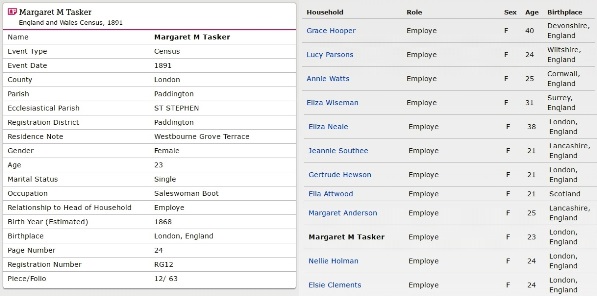
An example of a transcription from the 1891 English Census from Familysearch.org.
Detailed transcripts of English census records are available for free on FamilySearch and the images can be found for a fee at FindMyPast.
It is important to remember that for the census reports through 1901 the enumerator copied the household information into books, and these copies are what we have today.
Civil Registry of Vital Events
All English births, marriages, and deaths were required to be registered in a civil registration office beginning in July of 1837. In addition to the records themselves, there are indices which list the name of the person who was born, married, or died, the place where the event was registered, and the quarter and year in which the event occurred. Because the General Register Office (GRO) will only search one year on either side of the date provided, it is best, but not required, to include the index information when ordering documents from the GRO.
Free BMD is a free database which allows you the most freedom to search for the birth, marriage, and death index record of your relatives. You can enter whatever information you know including the place where the event happened, a specific year or range of years, age, and mother’s maiden name.
Depending on the time period, the index may be handwritten or mechanically printed. The information can then be used to order a copy of the actual record from the General Register Office (GRO) in England for about $10 per record.

An example of handwritten (left) and mechanically printed (right) birth index entries. Photos courtesy https://freebmd.org.uk.
The information contained in birth records includes:
- Name, date, and place of birth;
- Father’s name (if given at time of registration), occupation; and
- Mother’s name, maiden surname.
The parents’ places of birth were added after 1969, and the mother’s occupation is listed after 1984.
Marriage records include:
- Date and place of marriage;
- Name, age and marital status (spinster/bachelor, widowed, divorced) of the bride and groom;
- Occupation and usual address;
- Name and occupation of the fathers of the bride and groom, with a note if either man was deceased at the time of the marriage;
- Names of the witnesses;
- Name of the person who solemnized the marriage.
Death records in the United States are often relied upon to provide the names of the parents. English death records do not include that information and therefore are not as useful for genealogical purposes. Each death record includes:
- Name, date, and place of death;
- Date and place of birth (before 1969 a certificate only showed age of deceased);
- Occupation and usual address;
- Cause of death;
- The identity of the informant.
There are other records available, which we will talk about in a later post, which can be used to find and trace your English family members. The largest group are the religious records, and sometimes those can help you extend your family back in time to the 1600s – 400 years or more!
Beginning British Genealogy Important Take-Aways…
- “Great Britain” is an island. “The United Kingdom” is a country. And “England” is a country. Normally, when people are talking about their British ancestors they are referring to their English ancestors.
- England has counties, or what used to be known as “shires,” which function sort of like our states. The borders have changed over time, as have some of the names, so use a map when necessary to verify where you are researching.
- Census records are available from 1841 through 1911. Really good transcriptions are available for free at Family Search, or on the for-fee site Find My Past. And remember that age idiosyncrasy about the 1841 census.
- Finally, civil birth, marriage, and death records are available from the GRO. You can use the index listings to find the most likely match for your ancestor, and those can be found online at Free BMD.
Have fun and good luck finding your English ancestors!
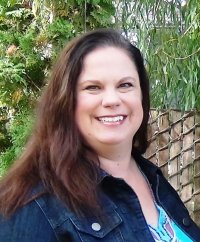 Kate Eakman is a Senior Researcher for Legacy Tree Genealogists, a worldwide genealogy research firm with extensive expertise in breaking through genealogy brick walls.
Kate Eakman is a Senior Researcher for Legacy Tree Genealogists, a worldwide genealogy research firm with extensive expertise in breaking through genealogy brick walls.
Click here to learn more about Legacy Tree services and its research team.
(Read our Disclosure and Affiliate Disclaimer on this page)














